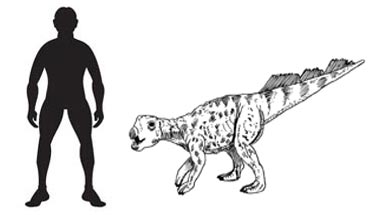Young Psittacosaurus Fossils Demonstrate Herding Behaviour
A joint research team from the Royal Tyrrell museum of Alberta, Canada and the Chinese Academy of Sciences have found the fossils of six juvenile psittacosaurs in what may be a dinosaur crèche.
The extremely well preserved, and almost complete skeletons show six individuals ranging in age from approximately 18-months to 3-years old. These unfortunate youngsters were buried in a volcanic mudflow as it engulfed a hillside 123 million years ago – (Aptian stage, Lower Cretaceous).
These fossils are yet another remarkable find from the Liaoning province of China, famous for the discovery of a number of feathered theropod dinosaurs such as Microraptor, Protarchaeopteryx and Caudipteryx, they may provide evidence of social behaviour in dinosaurs.
Dinosaur Nursery
The different age ranges of the animals show that these creatures were not from the same brood, they are not siblings and as they were buried relatively quickly this indicates that they were together living as a group. If the animals had perished in a drought it is likely that different age groups would congregate together around the remaining water sources and any remains preserved would provide relatively unreliable evidence of any social behaviour. However, these animals were buried in a volcanic mudflow, a sudden event and this does provide strong evidence that these young dinosaurs lived together. Whether they were part of a much larger herd with older individuals and adults who were able to avoid the mudflow is unknown. Perhaps young psittacosaurs lived in groups apart from the adults, only joining the adults when they reached sexual maturity.
Herding Behaviour
Herding behaviour has been established for a number of dinosaur genera including other Marginocephalia such as Centrosaurus and Protoceratops. However, Psittacosaurus lived earlier than these other Marginocephalians and their lack of horns and skull adornments led palaeontologists to question whether animals such as Psittacosaurus lived in social groups.
Could this new discovery shed some light on the evolution of herding behaviour and social hierarchy amongst dinosaurs? Scientists had thought that dinosaurs with horns and elaborate frills evolved to help them stand out as individuals within a herd structure, helping them obtain social status, find mates and warn off rivals. Now this find reveals that social groups of dinosaurs had formed long before the evolution of horns, frills and other facial adornments.
Dr Paul Barrett, of the Natural History Museum in London, one of the researchers, said that the fossilised juveniles appeared to have formed a crèche but it was impossible to be sure if they were part of a larger herd or if they grouped together for protection.
“This is the first time we’ve found a group of these dinosaurs together. For at least the first few years of life it looks like they stuck together. It answers the chicken-or-egg question of whether the social behaviour or the horns and frills came first,” he said. Dr Barrett is one of the consultants on the Natural History museum range of model dinosaurs. This scale model series is currently being reviewed and we are working on a few changes, more will be revealed next year.
To view Natural History museum models (no Psittacosaurus but a relative – Triceratops in the collection) and to see the rest of the prehistoric animal models in stock at Everything Dinosaur: Dinosaur and Prehistoric Animal Models.
“Parrot Lizard”
Psittacosaurus (means parrot lizard after the animal’s parrot like beak), was a small herbivorous dinosaur of the Early Cretaceous. At least 12 different species are known with remains having been found in China, Mongolia, Russia and possibly Thailand. It is one of the best known dinosaur genera with over 420 individual fossils having been found from hatchlings right up to fully grown adults. Not a large dinosaur by any means, some species could grow up to 2 metres long, perhaps these animals lived in groups for mutual protection against predators, just as small antelope do today. Psittacosaurus is a favourite amongst palaeontologists because of the wealth of material that has been recovered. Psittacosaur fossils are so numerous that they have been used as an index fossil to help date the Lower Cretaceous strata of South East Asia.
Psittacosaurus is classified as a Marginocephalian, perhaps a descendant of the great horned ceratopsians of the later Cretaceous. Quite how Psittacosaurus is related to these elephant sized later dinosaurs is a mystery. Large ceratopsians from the Campanian and Maastrichtian stages of the Late Cretaceous retain a fifth digit on the front feet. This fifth finger is supposed to be a primitive feature, perhaps retained to help bare the weight of these heavy animals. However, all psittacosaurs only have four fingers on their hands, having lost the fifth digit already. Psittacosaurs were relatively swift runners, capable of adopting a bipedal stance so perhaps the fifth digit re-evolved in later ceratopsians as a result of their more quadrupedal lifestyle. This theory is controversial as once an element such as a digit is lost from an order of animals it is not likely to re-evolve in later descendants.
So despite having a vast collection of psittacosaurs to study, we do not know how they fit into the dinosaur family tree. What we may be able to surmise from this remarkable find from Liaoning, is that they lived in “family” groups and demonstrated social behaviour.







Leave A Comment